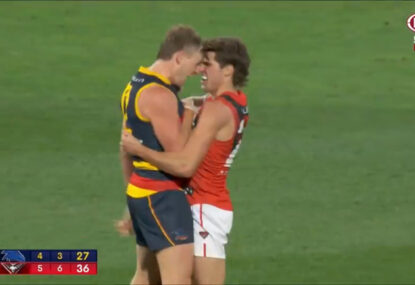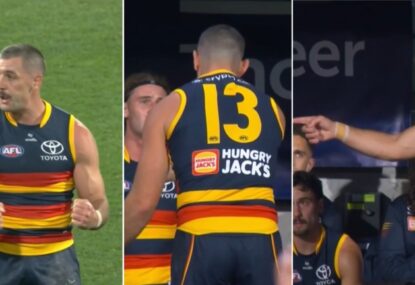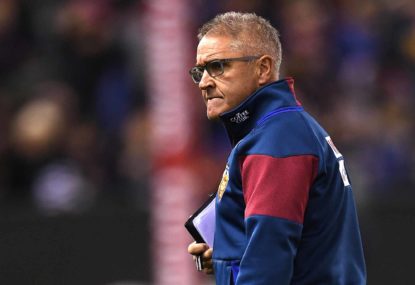Like any AFL nut in desperate need of a new hobby this off-season, I eagerly awaited the release of the 2019 fixture.
I don’t have a crystal ball, so my predictions are not going to be 100 per cent accurate. But by looking at the fixture, fans can gain a realistic insight into the challenges each team will face.
Last year I didn’t publicise my predictions, but from looking at the 2018 fixture, I believed that Collingwood would rise and Essendon would fall.
The extent of their rise and fall was greater than I imagined, but the point is that based on their 2017 performances, I could see a Collingwood that was underachieving and an Essendon that was overachieving and thought that their 2018 performances would somewhat correct that imbalance.
This isn’t to toot my own horn.
I also thought that Adelaide would claim consecutive minor premierships and West Coast would miss out on the top eight.
So, fixture analyses are both useful and limited in ascertaining the success of a team.
They are useful in predicting how a team will fare when there are apparent discrepancies between their ladder position from another season and their performance.
But they are also limited in that they are not scientific.
Past performance does not necessarily indicate future performance, although this analysis will draw upon evidence from the 2018 season in the absence of data from the 2019 season.
And no amount of data can ever identify the intrinsic factors that make a great team.
There is what I call the ‘Richmond factor’, where an otherwise hot-and-cold team finds its feet suddenly and becomes a juggernaut.
There is also the ‘Crows disease’, when a team that is judged to be right within its premiership window suddenly falls apart.
These things cannot be easily predicted and, at the end of the day, that’s what makes footy worth watching.
This analysis just considers the road each team must travel in 2019 and some of the realistic challenges they may face.
Rather than go through each team alphabetically, I have separated the teams into each of their relevant categories.
The categories are the Early Bolters, On the Rise, Slow Starters, Make or Break, Steadying, Declining and Hard To Tell.
When listing the games, I have indicated the location of the game when it’s relevant to the outcome of the match.
Early Bolters
Fremantle
Double-ups: Essendon, Port Adelaide, St Kilda, Western Bulldogs, West Coast.
Freo are by no means the first team that comes to everyone’s mind when it comes to success in 2019.
But the Dockers will be off to a flying start, mostly due to the quality of the other teams they play at the first part of the season.
The addition of Jesse Hogan and Rory Lobb in their forward line should also help despite the loss of Lachie Neale in the midfield.
Their first six games are against North Melbourne (in Perth), Gold Coast, St Kilda (in Perth), West Coast, GWS and the Western Bulldogs (in Perth).
With a bit of consistency and a good run with injuries it is not unreasonable to predict Fremantle to be 4-2 after Round 6.

Nat Fyfe’s Dockers have been gifted a gentle start to the season. (Photo by Daniel Carson/AFL Media/Getty Images)
Unfortunately, it will be downhill from there.
Fremantle then play Adelaide (in Adelaide), Richmond (in Perth), Essendon (Melbourne), Brisbane (in Perth) and Collingwood (Melbourne) before a much-needed bye.
After the bye, Fremantle play Port Adelaide (in Perth), Melbourne (in Melbourne), Carlton (in Perth), West Coast, Hawthorn (in Hobart) and Sydney (in Perth).
Their final six games are against the Western Bulldogs (in Melbourne), Geelong (in Perth), St Kilda (in Perth), Essendon (in Perth) and Port Adelaide (in Adelaide), where they should only find one or two wins.
With a developing team, it will be hard for Fremantle to make the distance and maintain a positive win-loss ratio throughout the year.
But there is always the potential that like West Coast last year, they get buoyed by early success and rise to the challenge.
Hawthorn
Double-ups: Brisbane, Geelong, GWS Giants, North Melbourne, West Coast.
Many people thought that Hawthorn was unworthy of finishing fourth on the ladder in 2018.
Hawthorn’s unexpected return to the top four after just one year of teething may pose problems for their finals hopes in 2019 as victims of ‘St Kilda Syndrome’, whereby a budding team over-achieves one year, which results in fixture problems the next.
However, the start of the season looks promising for Hawks fans and they have a genuine shot at being 6-0 after the first six rounds despite losing Tom Mitchell to injury.
This would be a handy buffer as the difficulty of the fixture increase and the additions of Tom Scully, Jack Scrimshaw and Chad Wingard – which hopefully offsets the losses of Ryan Burton and Taylor Duryea – may help Hawthorn to maintain their 2018 success.
Their first six games are against Adelaide, the Western Bulldogs, North Melbourne, St Kilda, Geelong and Carlton.
They only leave Victoria twice during this period – and one of those times they play in Tasmania where they perform strongly – and they would be starting favourites in four of these six games.
From there, it obviously gets more difficult.
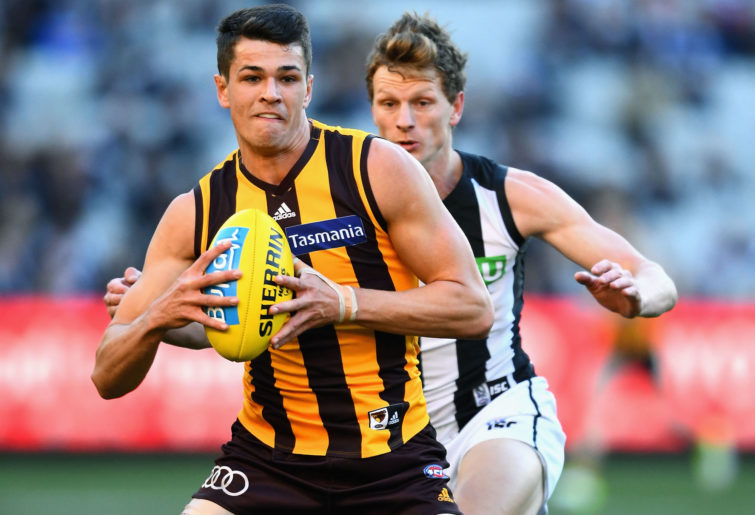
Ryan Burton’s Hawks will struggle to reproduce their top four finish from 2018. (Photo by Quinn Rooney/Getty Images)
Hawthorn play Melbourne, GWS (in Melbourne), Richmond, Port Adelaide (in Melbourne) and Brisbane (in Brisbane) before a bye.
All of those games will be difficult, and the Melbourne and Richmond games have the potential to be the blockbuster games of the round as the teams near the top of the ladder meet for the first time in 2019.
After the bye, things don’t get any easier for the Hawks.
They play Essendon, Sydney, West Coast (in Melbourne), Collingwood, Fremantle (in Tasmania) and Geelong.
In their home-stretch Hawthorn play Brisbane (in Hobart), North Melbourne, GWS, Gold Coast (in Melbourne) and West Coast.
Hawthorn’s 2019 success very much depends on whether they are able to step up as their 2018 performance likely won’t cut it in a more difficult fixture.
Although past performance isn’t a perfect indicator of future success, it is worth noting that of the teams Hawthorn play twice in the 2019 home-and-away season – Brisbane, Geelong, GWS, North Melbourne and West Coast – the Hawks lost to all of those teams except Geelong in 2018.
This gives perspective on the potential challenges Hawthorn will need to overcome to return to their 2018 success.
Slow Starters
These are teams that will have a difficult run at the start of the year which may leave significant ground to make up for the rest of the year.
That doesn’t mean that they won’t come good as the season gets underway, but the start of the year looks tough for them.
Some of these teams, like Brisbane, are probably more focused on incremental improvement than making finals so a couple of tough games early on probably won’t be a problem in the scheme of things.
Others, like Geelong, believe themselves to be in their premiership window so it is crucial that they withstand the tough opponents early on.
Brisbane
Double-ups: Gold Coast, Hawthorn, North Melbourne, Port Adelaide, Western Bulldogs.
A lot has been written about the growth of the current Lions’ list and just how far they can go in 2019.
The benefits for the Lions are that they have a young list where a degree of natural improvement can be expected from year to year.
The loss of Dayne Beams is worthy of its own article, but the additions of Lachie Neale and Jarryd Lyons should soften the blow and Marcus Adams and Lincoln McCarthy will add depth to the list, whether or not they are in the best 22.
2018 saw them rise from their 2017 ladder position but not so much that they are likely to contract ‘St Kilda Syndrome’.
The general consensus is that the Lions performed better than expected for the 15th team in the competition so a slightly harder fixture is not likely to throw them off.
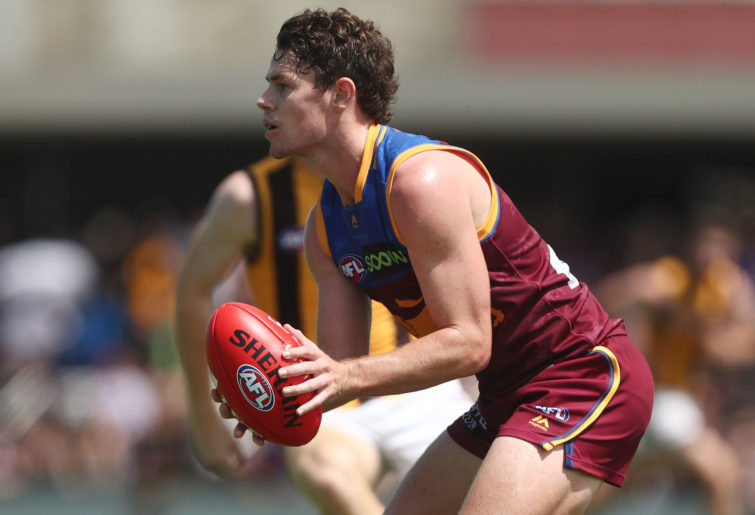
Lachie Neale’s new club are expected to be big improvers in 2019. (Photo by Chris Hyde/Getty Images)
Unfortunately for Brisbane, another slow start is likely for 2019. In their first six rounds, they play West Coast (in Brisbane), North Melbourne, Port Adelaide (in Brisbane), Essendon, Collingwood (in Brisbane) and Gold Coast. Lions fans would be happy with two or three wins here.
The good news is that it gets easier. Brisbane then play Sydney (in Brisbane), the Western Bulldogs, Adelaide (in Brisbane), Fremantle, Hawthorn (in Brisbane) and Carlton.
After that, the Lions are fresh from a bye and play St Kilda, Melbourne (in Brisbane), GWS, Port Adelaide, North Melbourne (in Brisbane) and Hawthorn (in Hobart).
In the last stretch they play the Western Bulldogs (in Brisbane), Gold Coast, Geelong (in Brisbane) and Richmond. The last two games could be deadening blows to Brisbane’s finals hopes but it won’t come to that.
It’s reasonable to expect the Lions will improve in 2019 although finals may be just beyond their reach.
The teams that they play twice – Gold Coast, Hawthorn, North Melbourne, Port Adelaide and the Western Bulldogs – are not unbeatable and, in recent years, the Lions have performed strongly at the Gabba.
A few strong performances on the road in winnable games – such as against Carlton, Fremantle and St Kilda – and some upsets at home against quality sides – like Adelaide, Hawthorn and Sydney – would see the Lions’ win-loss ratio improve.
Geelong
Double-ups: Adelaide, Hawthorn, North Melbourne, Western Bulldogs, Sydney.
Putting Geelong in the conversation for success in 2019 might go against the recent trend of previously unsuccessful clubs rising to glory through fairy tale success.
Geelong have been successful for over a decade, making finals every year from 2007 except 2015 and resisting calls for a rebuild.
Predictions of them sliding out of the eight have already surfaced, yet they still have the majority of the players from the list that had them finishing second in the home-and-away season less than two years ago. Plus, they have retained Tim Kelly.
The Cats will have a challenging start. Their opening six games are against Collingwood (in Melbourne), Melbourne (in Geelong), Adelaide (in Adelaide), GWS (in Geelong), Hawthorn (in Melbourne) and West Coast (in Geelong).
With the exception of Adelaide, all of these teams played finals in 2018. Geelong at their best can compete with any of those teams but it would be difficult to maintain themselves week in week out.
If Geelong were 6-0 at the end of Round 6, they would be almost certainly be early flag favourites, whereas a few slip-ups could mean they are playing catch up for the rest of season.
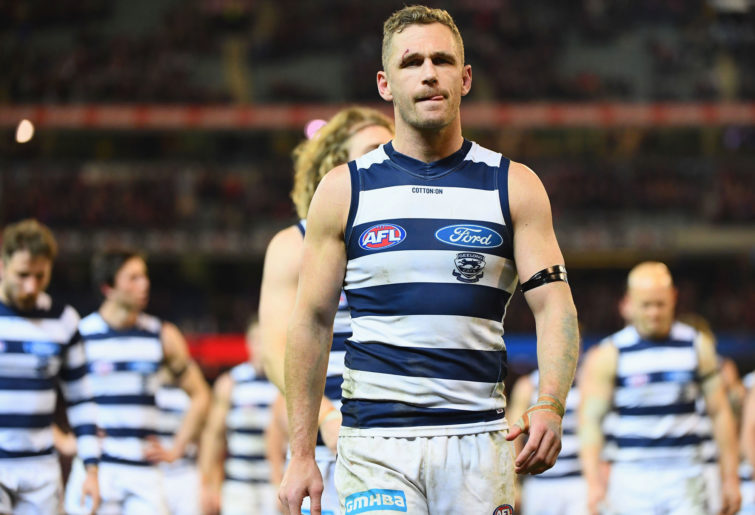
Joel Selwood’s Cats enjoy a soft run home. (Photo by Quinn Rooney/Getty Images)
Things then get somewhat easier. Geelong play Essendon (in Melbourne), North Melbourne (in Melbourne), the Western Bulldogs (in Geelong), Gold Coast, Sydney (in Geelong) and Richmond (in Melbourne) before a bye in Round 13.
After that, Geelong play Port Adelaide (in Adelaide), Adelaide (in Geelong), the Western Bulldogs (in Melbourne), St Kilda, Hawthorn (in Melbourne) and Sydney (in Sydney).
Their run home is at least easier as they play Fremantle, North Melbourne (in Geelong), Brisbane (in Brisbane) and Carlton. This last stretch could come in handy if Geelong have ground to make up from losses at the start of the season.
Geelong’s success will depend on whether the majority of their star players are still at their peak and whether the younger players are ready to step up.
Nevertheless, on experience, you would have to back Geelong’s list, so they will have easy wins against developing teams, and they will be able to compete with some of the top sides.
Geelong are capable of making the finals simply because they are better than more than half the teams in the competition, but the weighting of the fixture doesn’t always result in the final ladder reflecting the natural ability of each team.
However, Geelong still have the list that as recently as last year was talked about as having the potential to go all the way, and in 2019, they will have an easier fixture to the one they had in 2018.
On the Rise
Adelaide
Double-ups: Geelong, Gold Coast, Port Adelaide, St Kilda, West Coast.
Adelaide’s 2018 season was one to forget. From minor premiers in 2017 to coming 12th in 2018, Adelaide’s fall was rapid and spectacular.
Since their dominance in 2017, Adelaide have lost Charlie Cameron, Jake Lever and Mitch McGovern.
However, the re-signing of Rory Sloane and Tom Lynch will help steady the ship and a decent draft hand should help in putting fresh talent through.
Conservatively speaking, most commentators would agree that Adelaide are better than their 12th-place ladder position.
Adelaide’s opening six rounds are by no means guaranteed wins, but they are winnable.
They play Hawthorn (in Adelaide), Sydney (in Sydney), Geelong (in Adelaide), North Melbourne (in Melbourne), Gold Coast, and St Kilda. After their Round 1 loss to Hawthorn, at worst they might be 2-4 by the end of Round 6.
Adelaide then take on Fremantle (in Perth), Port Adelaide, Brisbane (in Brisbane), West Coast (in Adelaide), Melbourne (in Darwin) and GWS (in Adelaide).
After that they have Richmond (in Adelaide), a bye in Round 14, followed by Geelong (in Geelong), Port Adelaide, Gold Coast and Carlton.
Adelaide’s home stretch has them playing St Kilda, West Coast (in Perth), Collingwood and the Western Bulldogs.
What benefits Adelaide is their fixture. Going into 2018 as the top-ranked team from 2017, they faced a difficult fixture.
This was particularly difficult when after a few disappointing losses early in the season, they had a mountain to climb with mostly top eight teams to contend with.
The upside of their dramatic fall is that they will have a markedly easier fixture in 2019.
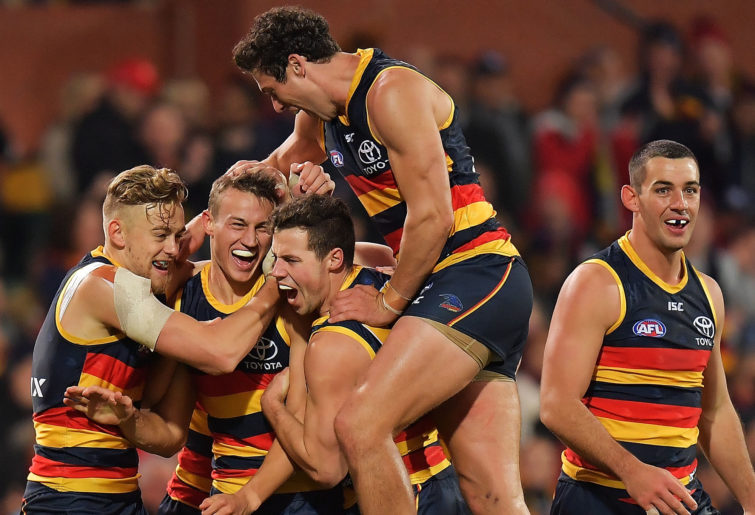
Adelaide’s disastrous 2018 campaign means they get an easier draw in 2019. (Photo by Daniel Kalisz/Getty Images)
They play Gold Coast and St Kilda twice in 2019, while in 2018 they played them once.
Add two extra wins to last year’s total of 12 wins and that would be enough to get Adelaide into the finals by 2018 standards.
They also play well at the Adelaide Oval and will likely start favourites even against top teams when playing there.
The question for Adelaide will be whether 2018 was a blip or symptomatic of an overall decline.
It’s a bit of both. Adelaide are not the seventh-worst team in the competition, but they are a far cry from their intimidating 2017 form.
Yes, Adelaide had a bad run with injuries – but while losing a couple of players to injury is bad luck, losing a mass of players speaks to poor management.
With a better pre-season and the wind blowing their way, Adelaide can shoot up the ladder and make the finals.
But 2017 was their year to win the premiership and some of Adelaide’s star players are just starting to pass their peak which makes me put them below the top-tier contenders like Richmond, West Coast, Melbourne and Collingwood.
Essendon
Double-ups: Collingwood, Fremantle, GWS Giants, North Melbourne, Sydney.
Essendon have been talked up for a while. Unfortunately, in 2018 they disappointed with their ladder position, but they did show just what they are capable of.
With the addition of Dylan Shiel in the off-season and with Adam Saad, Devon Smith and Jake Stringer having had a season to settle in, conventional wisdom is that Essendon is within their premiership window.
The trouble with Essendon is that they have failed to live up to expectations in recent years. The good news is that we will know quite early whether this is the usual under-performing Essendon team or if they have indeed changed.
Essendon kick off playing Greater Western Sydney (in Sydney), followed by St Kilda, Melbourne, Brisbane, North Melbourne and Collingwood. In those six games they will likely only be starting favourites in two or three of them.
Essendon then play Geelong (in Melbourne), Sydney (in Sydney), Fremantle, Richmond and Carlton before a bye.
After the bye, Essendon have Hawthorn, West Coast (in Perth), Greater Western Sydney (in Melbourne), Sydney (in Melbourne), North Melbourne and Adelaide.
Essendon’s run home sees them play Gold Coast, Port Adelaide, Western Bulldogs, Fremantle and Collingwood.

The fixture hasn’t done John Worsfold’s Bombers any favours. (AAP Image/Julian Smith)
Despite disappointing in 2018, Essendon’s fixture is barely any easier. Of the teams they play twice, none of them were bottom four in 2018 and it would not be a given that Essendon would get two easy wins against each of these teams.
Even Fremantle – the lowest-ranked of those five teams – looks revitalised and competitive for 2019 so Essendon can’t take finals as a given.
Essendon are an exciting team to watch with the potential to make the eight although they will face tight competition from a number of hungry teams from outside the eight.
Putting them in the discussion for the premiership is premature.
Make or Break
West Coast
Double-ups: Adelaide, Collingwood, Fremantle, Hawthorn, Melbourne.
The tale of a reigning premier that fails to back up their effort in the consecutive season is all too familiar.
West Coast are going to work hard to prove that that’s not them.
Of course, they will have added fixture difficulties, but West Coast showed themselves last year to be a well-oiled machine and there’s every reason to believe they will be a contender this year.
West Coast kick off the season with Brisbane (in Brisbane), then GWS (in Perth), followed by a grand final replay (in Melbourne) against Collingwood, then the derby against Fremantle, a clash with Port Adelaide (in Perth) and Geelong (in Geelong).
If there are any cracks in the West Coast armour, they will show up in these first six rounds.
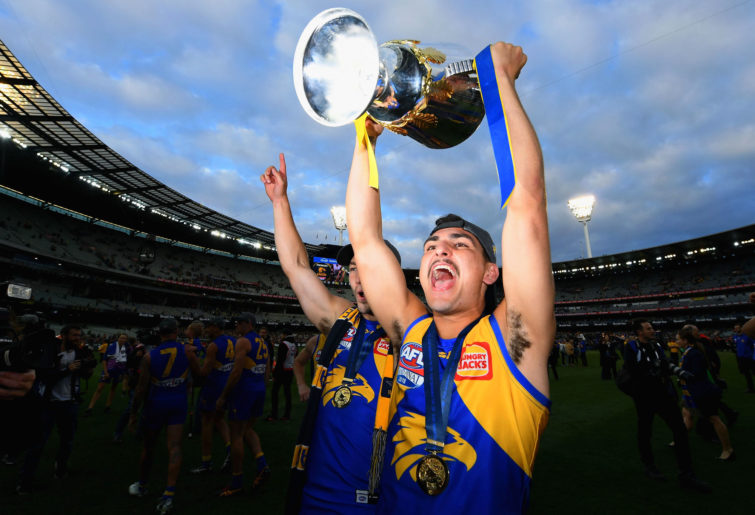
It’s always a challenge for reigning premiers to go back-to-back, as the Eagles will learn this year. (Photo by Quinn Rooney/Getty Images)
After that West Coast have Gold Coast, St Kilda, Melbourne (in Perth), the Western Bulldogs and Sydney (in Sydney).
West Coast have their bye in Round 13, followed by Essendon (in Melbourne), Hawthorn (in Melbourne), Fremantle, Collingwood (in Perth) and Melbourne (in Alice Springs).
The Eagles close the home-and-away season playing North Melbourne, Carlton, Adelaide, Richmond (in Melbourne) and Hawthorn (in Perth).
Backing up after 2018 won’t be easy but then again it never is when you’re the reigning premier.
West Coast won’t drop off but whether they can go back-to-back is another question.
Collingwood
Double-ups: Essendon, Melbourne, Richmond, West Coast, Western Bulldogs.
A lot of attention will be on how Collingwood fares in 2019 after surprising everyone and making the grand final.
Their list looks to be playing cohesively and they have experienced players returning from injury in addition to adding Dayne Beams.
This will be Collingwood’s opportunity to answer their critics who believe that the Magpies’ success came as a result of an easy fixture.
A similar thing was said about Richmond going into 2018 and Richmond was able to step up to being a champion team.
With the amount of hype surrounding Collingwood this season, it is clear that fans hope that the Pies will be able to do the same although there are difficulties from the outset with Collingwood having repeat games against Essendon, Melbourne, Richmond, West Coast and the Western Bulldogs.
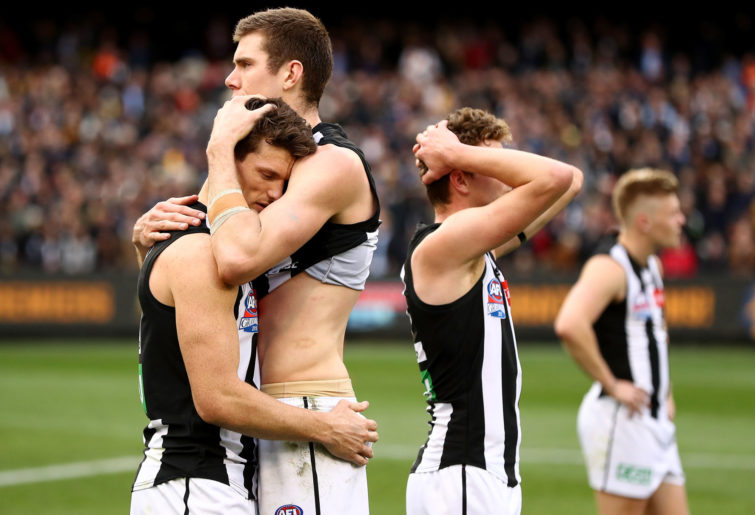
Buzz surrounds the Pies after their 2018 grand final appearance. (Photo by Ryan Pierse/AFL Media/Getty Images)
Nothing will come easy for Collingwood and they play their first games against Geelong (in Melbourne), Richmond, West Coast (in Melbourne), the Western Bulldogs, Brisbane (in Brisbane) and Essendon.
If they can weather this early onslaught, they can establish themselves as a 2019 juggernaut, although it would seem difficult to maintain consistency against all those quality sides.
After that they play Port Adelaide (in Melbourne), Carlton, St Kilda, Sydney (in Sydney), Fremantle (in Melbourne) and Melbourne before a bye in Round 13.
They then have the Western Bulldogs, North Melbourne, Hawthorn, West Coast, GWS and Richmond. Collingwood’s run home has them play Gold Coast (in Melbourne), Melbourne, Adelaide (in Adelaide) and Essendon.
Collingwood’s success depends on whether they really are the real deal and have stepped up to being one of the elite teams of the competition or if 2018 was just a flash in the pan.
Just when we will know this is unclear, although the first six rounds could give us an indicator, especially the grand final rematch and their grudge match against Richmond.
Having those matches back-to-back will be a real test of Collingwood’s endurance.
Another factor in Collingwood’s success is whether budding teams like Essendon and Melbourne – who Collingwood play twice – also step up.
Collingwood beat both those teams quite comfortably in 2018 although 2019 is obviously a new year.
Also, will Richmond and West Coast – who Collingwood also have double-ups with – still be the teams to beat in 2019?
Judging by the fanfare amongst Collingwood supporters after their narrow grand final loss and the general goodwill in the media, there is anticipation that Collingwood can rise to another level in 2019.
The onus will be on the players and coaching staff to make that a reality.
Richmond
Double-ups: Collingwood, Melbourne, GWS Giants, Port Adelaide, Carlton.
Richmond were arguably the most impressive team last year and, in the lead up to this season, there appears to be no sign of their form sliding.
Yes, they will have a difficult fixture, but the last two years have shown Richmond’s transformation from giant slayer to giant and they have demonstrated their capacity to rise to almost any challenge.
They will be in the team to beat in 2019 just as they were in 2018.

Richmond are the 2019 front-runners, even without Alex Rance. (Photo by Michael Dodge/Getty Images)
Richmond start the year off with their now traditional opening match against Carlton, followed by Collingwood, GWS (in Sydney), Port Adelaide (in Adelaide), Sydney (in Melbourne) and Melbourne.
This could be the toughest first six rounds in the competition.
When fully firing, Richmond can overcome any of these teams but to do it week in, week out for six rounds will be a tall order. Still, Richmond will be in the top half of the ladder after the first six rounds.
Richmond then take on the Bulldogs, Fremantle (in Perth), Hawthorn, Essendon, North Melbourne and Geelong. This could be a good opportunity for consolidation.
Richmond have Adelaide (in Adelaide) in Round 13 followed by a bye then St Kilda, Gold Coast, GWS (in Melbourne) and Port Adelaide (in Melbourne).
Richmond’s run home has them playing Collingwood, Melbourne, Carlton, West Coast and Brisbane.
Not the easiest set of teams to close out the season, but Richmond are likely to already have their spot in the top eight – if not the top four – locked up by then.
Melbourne
Double-ups: Collingwood, Richmond, St Kilda, Sydney, West Coast.
Melbourne have been popular picks for a fairy tale finish for the last two seasons.
Now is their time and their list is developed, with some even calling it the best squad in the AFL.
There are no excuses. However, with their recent success comes a difficult fixture that they must overcome.
Melbourne start the year against Port Adelaide (in Melbourne), followed by Geelong, Essendon, Sydney, St Kilda and Richmond.
If Melbourne want us to believe they are they real deal, they need to win most if not all of these matches and an upset against Richmond would show that they are worthy of their hype.

Dees coach Simon Goodwin has no excuses anymore. (AAP Image/Julian Smith)
Melbourne then have Hawthorn, Gold Coast, West Coast (in Perth), GWS, Adelaide and Collingwood.
Once again, in these tough matches, Melbourne need to rise to the occasion. Their difficult fixture means that they cannot rely on being flat-track bullies to make the finals.
Melbourne then have a bye followed by playing Fremantle, Brisbane (in Brisbane), Carlton, the Western Bulldogs and West Coast.
Melbourne’s run home doesn’t get much easier. They have Richmond, Collingwood, Sydney and North Melbourne.
Melbourne don’t want to go into this period with their place in the eight in the balance, as has been the case the past two years.
If Melbourne can live up the hype and overcome this fixture, then there is no ceiling on what they can achieve.
Steadying
Carlton
Double-ups: Gold Coast, Richmond, St Kilda, Sydney Swans, Western Bulldogs.
Carlton can’t get much worse than 2018 where they had two wins and received the wooden spoon.
Since then they have obtained Mitch McGovern and some quality draft picks.
Carlton will improve slowly but Blues fans will have to be patient as 2019 will be another year in the bottom four.
Carlton start the year against Richmond, Port Adelaide, Sydney, Gold Coast (at the Gold Coast), the Western Bulldogs and Hawthorn. As it stands, they may only be favourites against the Gold Coast, if that.
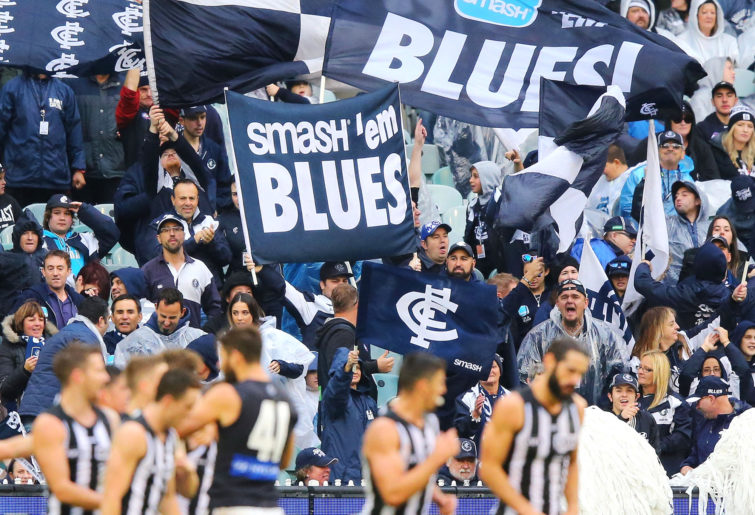
It’s going to be another lean campaign for the long-suffering Carlton faithful. (Photo by Michael Dodge/Getty Images)
Carlton then have North Melbourne, Collingwood, Greater Western Sydney, St Kilda, Essendon and Brisbane (in Melbourne).
After that, Carlton play the Western Bulldogs, followed by a bye, then Fremantle (in Perth), Melbourne, Sydney, Gold Coast (in Melbourne) and Adelaide.
Carlton’s home stretch sees them playing West Coast, Richmond, St Kilda and Geelong, but it won’t matter. Finals are not likely to be on the table for Carlton.
In almost all their games, Carlton will be the underdog.
Sure, upsets occur, and Carlton should hope to improve their two-win tally from 2018 but Blues fans will likely have to sit patiently for another year as their young players develop.
St Kilda
Double-ups: Adelaide, Carlton, Fremantle, Gold Coast, Melbourne.
St Kilda are a regular feature in the bottom four of footy pundits.
In 2018 they finished 16th and a number of commentators think that their fortunes haven’t improved despite the addition of Dan Hannebery.
Yet it should be noted that St Kilda will face an easier fixture as a result of finishing 16th last year, while in 2018 they had a more difficult fixture as a result of finishing 11th in 2017.
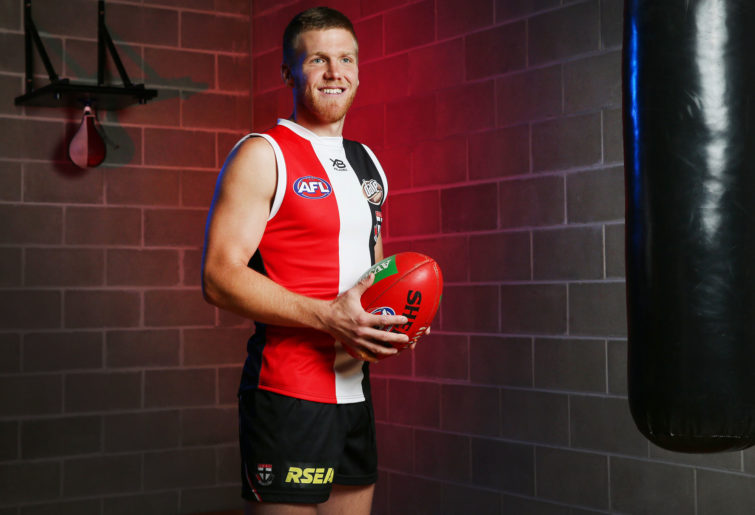
The recruitment of Dan Hannebery won’t save the Saints from another tough season. (Photo by Michael Dodge/Getty Images)
St Kilda open their season by playing Gold Coast, followed by playing Essendon, Fremantle (at Optus), Hawthorn, Melbourne and Adelaide. You would have to say that St Kilda would be the underdogs in all of those games except against Gold Coast.
St Kilda then have GWS, West Coast, Collingwood, Carlton and Port Adelaide (in China) before a Round 12 bye. Once again, St Kilda will likely be lower rated than all of their opponents except possibly Carlton.
St Kilda then take on Gold Coast, Brisbane, Richmond, North Melbourne, Geelong and the Western Bulldogs.
Saints fans would be not accepting anything less than one win in this bracket and they would be hoping desperately for another win against Brisbane, North Melbourne or Western Bulldogs although they would likely be underdogs in each of those games.
St Kilda’s run home sees them playing Adelaide (in Adelaide), Fremantle (at Marvel), Carlton and Sydney.
Perhaps St Kilda could nab two wins against Carlton and Fremantle here, but even then, they would likely be finishing the season with far more losses than wins.
Sydney
Double-ups: Carlton, Essendon, Geelong, GWS Giants, Melbourne.
The Sydney Swans have been a mainstay in finals for several years although they haven’t won a premiership since 2012 and many pundits have been quick to predict their decline.
Still, Sydney have a habit of surprising their critics and have retained most of the squad which a year ago was talked up as being one of the best lists in the competition.
At their best Sydney beat the eventual premiers twice last year, while at their worst, they were defeated by the Gold Coast.
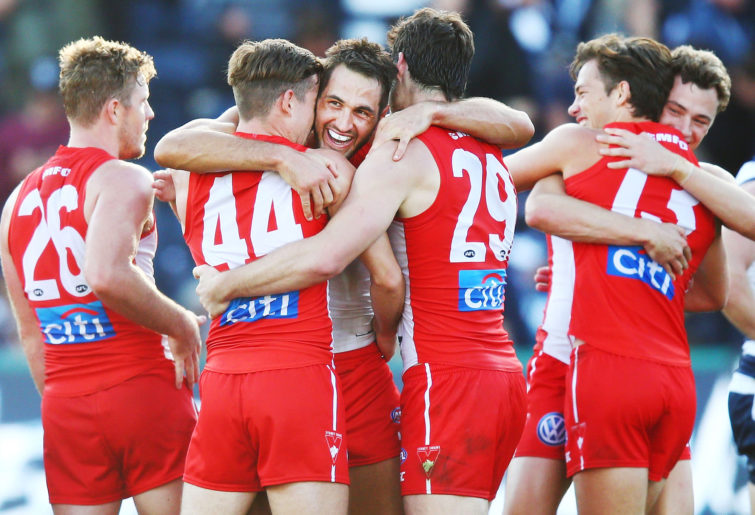
The Swans were rocks or diamonds in 2018. (Photo by Michael Dodge/Getty Images)
Sydney play the Western Bulldogs (in Melbourne) in Round 1 followed by Adelaide (in Sydney), Carlton, Melbourne (in Sydney), Richmond (in Melbourne) and GWS. Such a grouping will give an indication of whether Sydney’s list is indeed past its peak.
Sydney then have Brisbane (in Brisbane), Essendon (in Sydney), North Melbourne, Collingwood (in Melbourne), Geelong (in Geelong) and West Coast (in Sydney).
The Swans have a bye in Round 13 then Hawthorn (in Sydney), Gold Coast, Essendon, Carlton and Fremantle.
Their home stretch has them playing Geelong (in Sydney), GWS, Port Adelaide (in Adelaide), Melbourne (in Melbourne) and St Kilda.
Sydney’s lack of impact last year despite making the finals, as well as the surprising form of teams like West Coast and Collingwood, has meant that the Swans are often tipped to miss the eight in 2019.
Then again, this time last year may pundits had West Coast as the most likely finalist from the previous year to miss out on finals. Sometimes the lack of expectation can be a blessing in disguise.
Declining
Gold Coast
Double-ups: Adelaide, Brisbane, Carlton, GWS Giants, St Kilda.
There isn’t much further Gold Coast can sink, but with the departures of Tom Lynch, Steven May, Jarryd Lyons, Aaron Hall, Kade Kolodjashnij and others, their team looks ill-equipped to even compete in the AFL.
The question isn’t whether Gold Coast can win the premiership or play finals, the question is whether they can win a game.
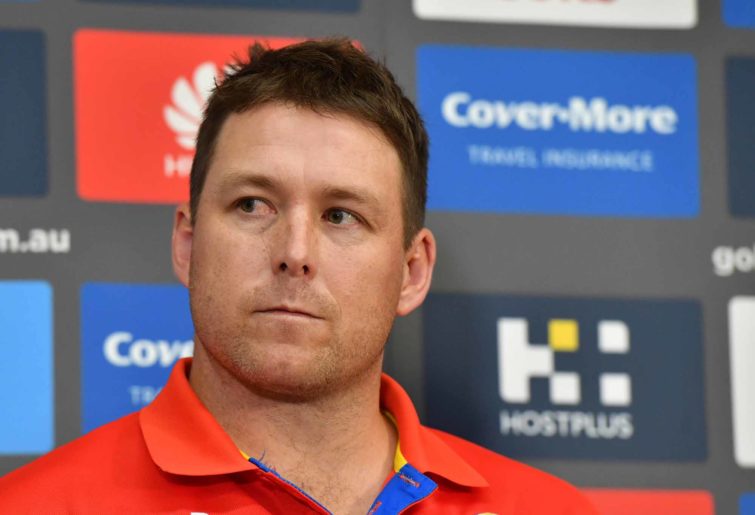
Gold Coast Suns coach Stuart Dew faces another challenging campaign. (AAP Image/Darren England) NO ARCHIVING
Round 1 would be a good place to start, but they’re underdogs even against St Kilda.
Gold Coast then have Fremantle (at the Gold Coast), Western Bulldogs, Carlton, Adelaide (in Adelaide) and Brisbane (at the Gold Coast). Barring Adelaide, this stretch isn’t too bad but Gold Coast will almost certainly be the underdogs in all of these games.
Gold Coast then have West Coast, Melbourne, Port Adelaide, Geelong, GWS and North Melbourne.
The Suns take on St Kilda in Round 13, followed by a bye then Sydney, Richmond, Adelaide and Carlton (in Melbourne).
The Suns final games are against Collingwood, Brisbane (in Brisbane), Hawthorn and GWS.
It is obvious that Stuart Dew has flicked the reset switch on the Suns.
They won’t be good this year, but the upside is they will have a stack of draft picks that in years to come could make them a dynamic force… if those picks hang around.
Greater Western Sydney
Double-ups: Essendon, Gold Coast, Hawthorn, Richmond, Sydney.
GWS have been regularly tipped to go all the way over the past few years.
They haven’t, but in 2016 they came close, losing to the eventual premiers the Western Bulldogs in the preliminary final. Again, in 2017, the Giants lost to the eventual premiers Richmond in the prelim.
GWS then appeared to go backwards in 2018, still making the eight but missing out on the top four and going out to Collingwood in the semi-final.
Since then, GWS have lost quality players like Dylan Shiel, Rory Lobb and Tom Scully.
They still have a quality list but they are no longer head and shoulders above the other developing teams as the pressures of the salary cap start to bite and they can no longer rely on the AFL to give them draft hand-outs.
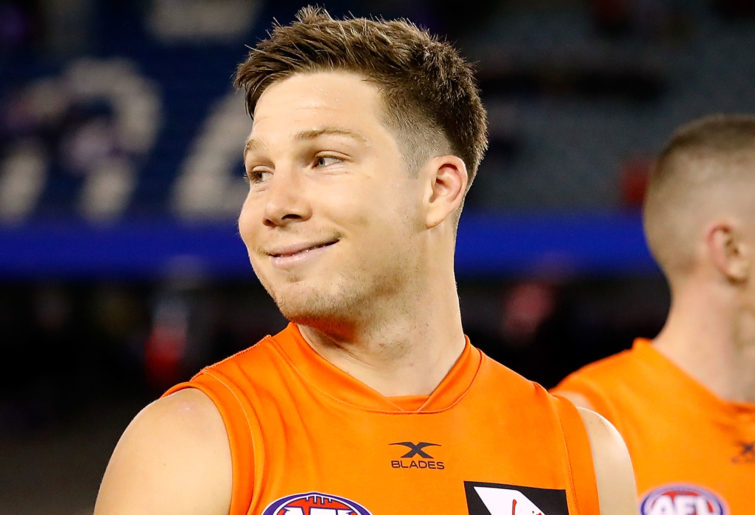
Will Toby Greene have that smile on his face come the end of 2019? (Photo by Adam Trafford/AFL Media/Getty Images)
GWS start the year facing Essendon (in Sydney), followed by West Coast (in Perth), Richmond (in Sydney), Geelong (in Geelong), Fremantle and Sydney. This stretch will be a good opportunity to see whether they are worthy of being talked up as premiers.
GWS then have St Kilda, Hawthorn (in Melbourne), Carlton, Melbourne (in Melbourne), Gold Coast and Adelaide (in Adelaide).
The Giants then have North Melbourne (in Hobart), a bye in Round 14 then Essendon (in Melbourne), Brisbane (in Sydney), Richmond (in Melbourne) and Collingwood (in Sydney).
If GWS are looking to consolidate their place in the eight, then the run home will help. The Giants face Port Adelaide (in Adelaide), Sydney, Hawthorn (in Canberra), the Western Bulldogs and Gold Coast.
The Giants could well be in contention for the eight, but that list of contenders is crowded.
The challenge will be for them to recapture the form that made them look so dangerous in 2016 and 2017. And to retain both Josh Kelly and Stephen Coniglio.
North Melbourne
Double-ups: Brisbane, Geelong, Essendon, Hawthorn, Port Adelaide.
North Melbourne were a surprise to a lot of people in 2018.
Many picked them as cellar dwellers, but they instead surged into contention for the top eight.
They fell just short and many posit that with the additions of Jared Polec, Jasper Pittard and Aaron Hall, they could surge into contention for the top eight.
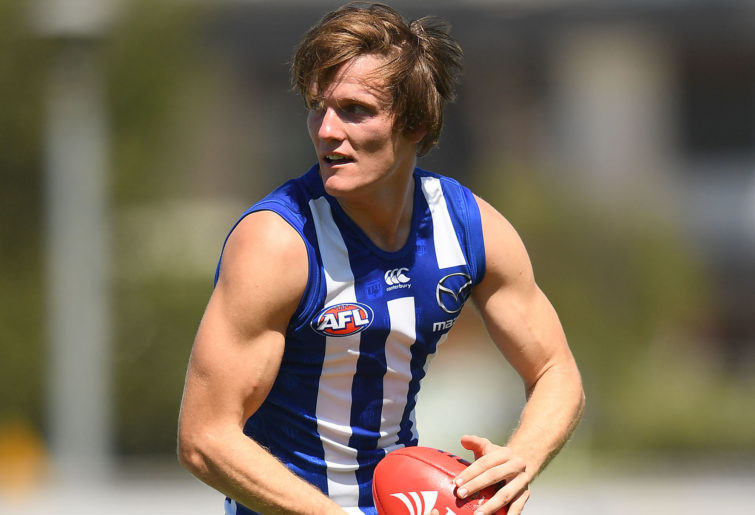
Jared Polec will help the Roos make the possible leap into September. (Photo by Quinn Rooney/Getty Images)
Unfortunately, with this rise up the ladder comes the added headache of a more difficult fixture.
Whether the Kangaroos’ new recruits are enough to neutralise their tough fixture will be the question surrounding them for 2019.
North Melbourne kick off against Fremantle (in Perth) then they play Brisbane (in Melbourne), followed by Hawthorn, Adelaide (in Melbourne), Essendon and North Melbourne.
This will be an important time for the Kangaroos to stamp their authority amongst a crowded group of contenders.
They then take on Carlton, Geelong (at Marvel), Sydney (in Hobart), the Western Bulldogs, Richmond and the Gold Coast.
In Round 13, North Melbourne have GWS followed by a bye then Collingwood, St Kilda, Essendon and Brisbane (in Brisbane).
For North fans, just missing the finals two years in a row would be devastating which is why it is important that they lock in the wins early as their run home will be challenging.
They close out their season with West Coast (in Perth), Geelong (in Geelong), Port Adelaide (in Melbourne) and Melbourne.
Port Adelaide
Double-ups: Adelaide, Brisbane, Fremantle, North Melbourne, Richmond.
Port Adelaide were a disappointing team in 2018.
After finishing the first three rounds 3-0, they fizzled out and lost their final four matches and missed the finals.
Now they have lost Chad Wingard, Jared Polec and Jasper Pittard, which will likely hurt them in the short term while their talented draft picks take time to mature.
This season will be crucial in determining whether the Power will be able to capitalise on their potential or find themselves rebuilding without tasting September glory.
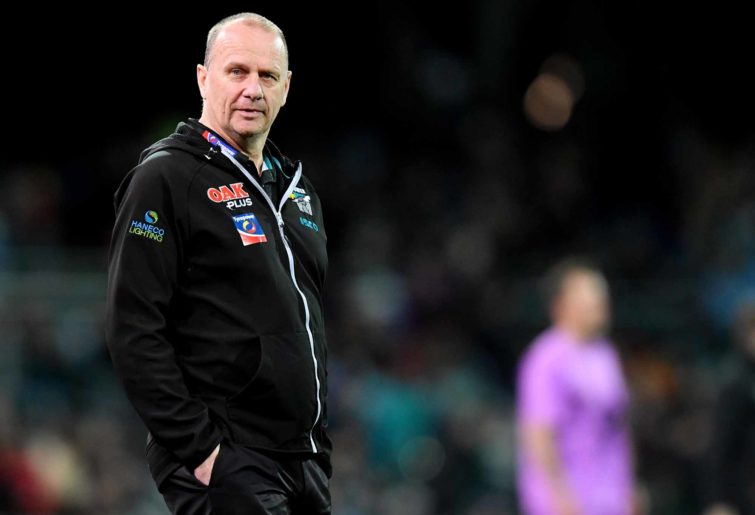
Port coach Ken Hinkley is under pressure in his seventh season at the helm. (AAP Image/Kelly Barnes)
Port Adelaide start the season against Melbourne (in Melbourne), followed by Carlton, Brisbane (in Brisbane), Richmond (in Adelaide), West Coast (in Perth) and North Melbourne (in Adelaide).
These matches will be critical for Port to answer their critics and show their enduring relevance, particularly against three teams (Melbourne, Richmond, West Coast) who are predicted to go deep in September.
Port Adelaide then face Collingwood (in Melbourne), Adelaide, Gold Coast, Hawthorn (in Hobart) and St Kilda before a bye in Round 12.
Fresh from the bye, Port Adelaide travel to Perth to play Fremantle, then they have Geelong, the Western Bulldogs, Adelaide, Brisbane (in Brisbane) and Richmond (in Melbourne).
Port Adelaide’s run home sees them play Essendon (in Melbourne), Sydney, North Melbourne (in Melbourne) and Fremantle.
Port Adelaide will need to move fast or risk falling behind amidst an array of rapidly improving teams.
However, on the plus side, they might benefit from a lack of pre-season hype as West Coast did last year.
Plus, their 2018 recruits who under-performed in their first season at Port – Tom Rockliff, Jack Watts and Steven Motlop – will hopefully be more settled.
Hard to Tell
Western Bulldogs
Double-ups: Adelaide, Brisbane, Carlton, Collingwood, Geelong.
The Western Bulldogs are perhaps the hardest team to pick.
Only three seasons ago they won a premiership.
Sure, they’ve lost a few players such as Bob Murphy, Jake Stringer and Luke Dahlhaus but their star players like Marcus Bontempelli, Jackson Macrae and Jason Johannisen are still young and the Dogs have some exciting draft picks.
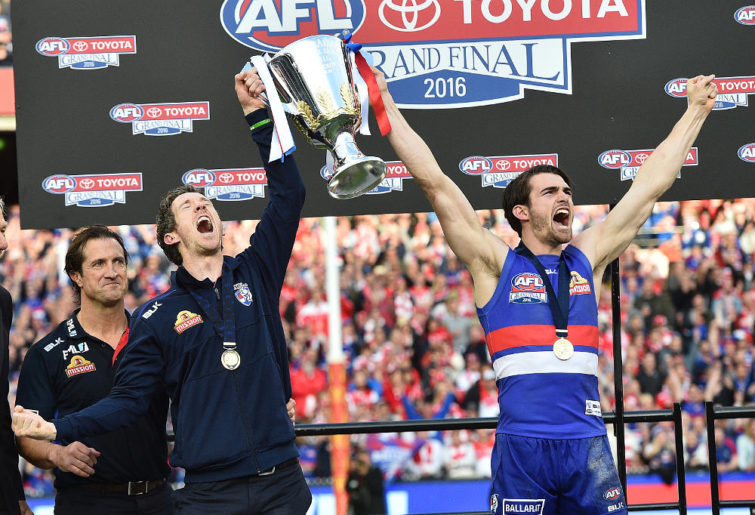
The Dogs have flopped since their shock 2016 flag. (AAP Image/Julian Smith)
The Bulldogs face Sydney (at Marvel), followed by Hawthorn, Gold Coast, Collingwood, Carlton and Fremantle (at Optus). All of those games are winnable but then again, the Bulldogs lost to the Gold Coast in the JLT.
The Bulldogs then take on Richmond, Brisbane (in Ballarat), Geelong, North Melbourne, West Coast (at Optus) followed by a bye in Round 12.
After that, the Bulldogs have Carlton, Collingwood, Adelaide (in Adelaide), Geelong, Melbourne and St Kilda.
The Bulldogs’ run home sees them play Brisbane (in Brisbane), Essendon, GWS, and Adelaide.
Of the bottom six teams from last year, the Bulldogs arguably have the greatest depth to propel themselves to finals.
Their draw does not look overly difficult although improvement from Brisbane and Carlton – who the Dogs play twice – means that Luke Beveridge can’t count on an extra two wins automatically.
Final thoughts
The last three premiers were scarcely predicted.
Obviously, I won’t get all my predictions right and it would be a boring season if I did.
Many would question, then, what is the point of this extended analysis?
It is important before making predictions to look at each team’s fixture challenges for the year.
I’m not a fortune teller but by looking at the fixture, I can identify likely challenges for each team – some of which will be overcome.
To avoid being labelled a fence-sitter, I’ll have a go at predicting the ladder.
Undoubtedly this will be wrong, but I make this prediction with due calculation of each team’s fixture advantages and difficulties.
1. Richmond
2. Melbourne
3. West Coast
4. Collingwood
5. Geelong
6. Adelaide
7. Sydney
8. Hawthorn
9. Essendon
10. Brisbane
11. Port Adelaide
12. North Melbourne
13. Western Bulldogs
14. GWS Giants
15. Fremantle
16. St Kilda
17. Carlton
18. Gold Coast
















































































































